
A week ago, we met Bob and Sandra Alston on their farm in New Brunswick and learned a few things about covered bridges, their farm, and tourism in the Maritimes. When we told them that our trip would take us all the way to Newfoundland, the two of them, nearly simultaneously, asked if we’d be visiting Flowers Cove. Hearing that we knew nothing about the location, they enthusiastically shared details of their first visit to this fossil site on the Great Northern Peninsula of Newfoundland and that thrombolites were the main attraction. I assumed they meant stromatolites, as found at Shark Bay, Australia, which certainly piqued our interest. We noted it and started looking into the place after we drove away. Following our itinerary, we had planned to visit Gros Morne National Park, about 75 miles (120km) north of our hotel today, while Flowers Cove was 228 miles (367km) farther north. Adding a few hundred extra miles of driving would mostly eliminate a proper visit to the national park.
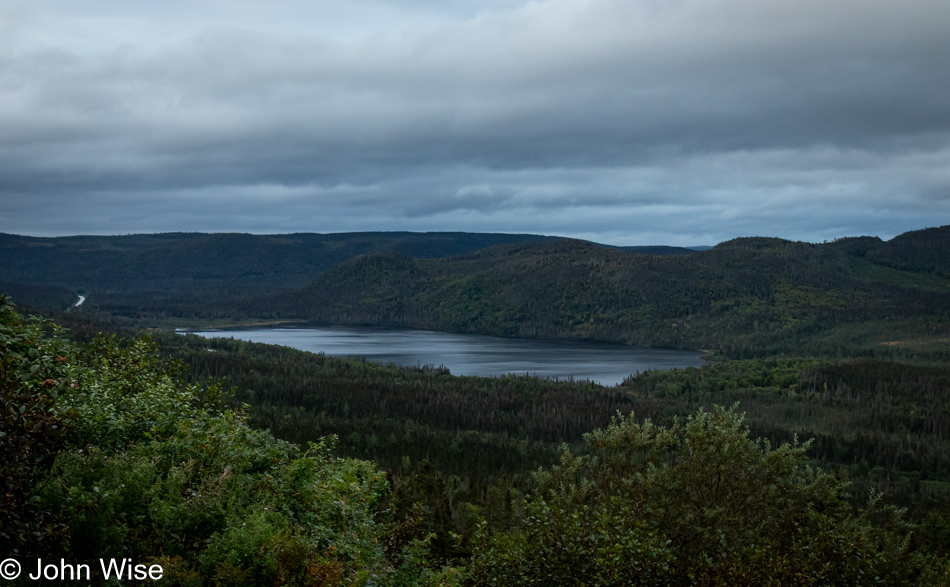
After last night’s terror storm and this morning’s forecast for “cloudy with a chance of more rain,” we decided to opt for the rare opportunity to visit one of only two sites on earth where this type of fossil is located instead of hiking under gray skies. Certain that this was the better option for spending our first day in Newfoundland, we were off shortly after sunrise. There is a dilemma buried in this decision because Gros Morne, a world-renowned site known for its spectacular beauty, was supposed to be the first national park we’d visit in Newfoundland, and I had planned some great hikes for us, yet here we are, heading to a relatively unknown location, to us anyway, whose only promise was that we’d be in the car for a majority of the day, though at least not in the rain.

The cloud cover breaking up above us does nothing to change our intention to visit Flowers Cove because, by now, we are excited to see the lumps of cyanobacteria fossils awaiting our visit.

We are sacrificing four hikes in the park today under increasingly beautiful skies, not the gloom we were threatened with earlier. I have to wonder about this process that predicts bad weather only to be replaced by heavens of blue punctuated with little fluffy clouds. I know the answer: it is the dynamic energy created by the presence of the two of us and our overwhelming abundance of love that thwarts the weather gods’ ideas of putting a damper on our parade, thus allowing the universe to entertain us with joyful brilliance during our explorations.
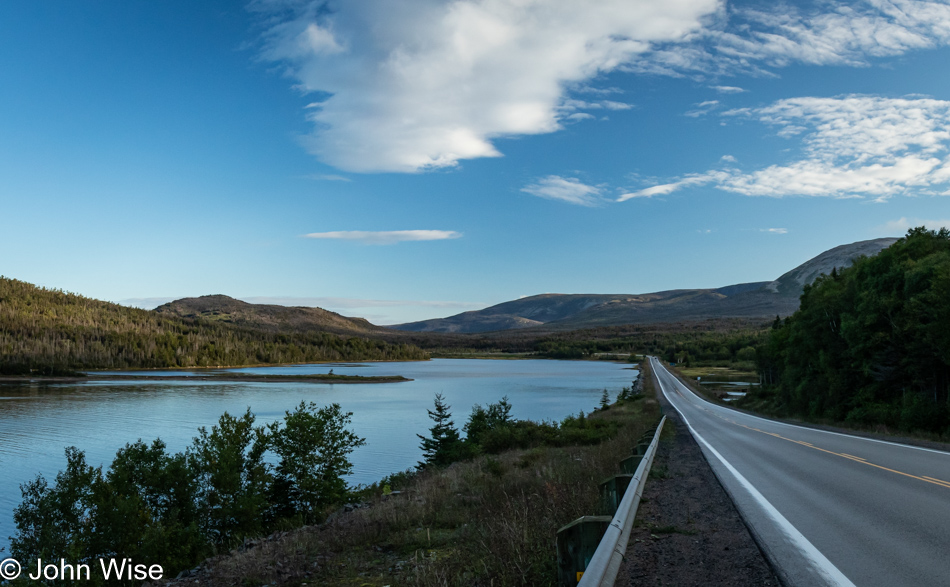
Not knowing if the heavier clouds would remain at bay, the idea motivating the frequent stops was to capture as much of the emerging beauty of the Great Northern Peninsula we were heading into. Not knowing if we should ever again have an opportunity to explore such a remote land, we need to go slow and take in as much as possible, which isn’t performed efficiently when in a moving car, though I’d argue that a little something and even weak first-hand impressions are better than nothing.

Looking across the landscape, the most evident feature to pick up on is the need to linger here, there, and everywhere. These momentary glances do not allow the environment to sink in properly, and by now, we are well enough traveled to understand that relatively brief visits will not permit these sights to penetrate our minds with a deep level of familiarity where we gain a sense of knowing the place. We would require a solid week or more, just in this general area, watching the weather come and go while inching across the shore, trails, and mountains to see and hopefully feel the tiniest fraction of understanding where we are. That, though, is not what life offers us. We have limited amounts of time to dedicate to such pursuits with equally limited budgets. That is the reality of tempering what one desires against the circumstances of what one can achieve.
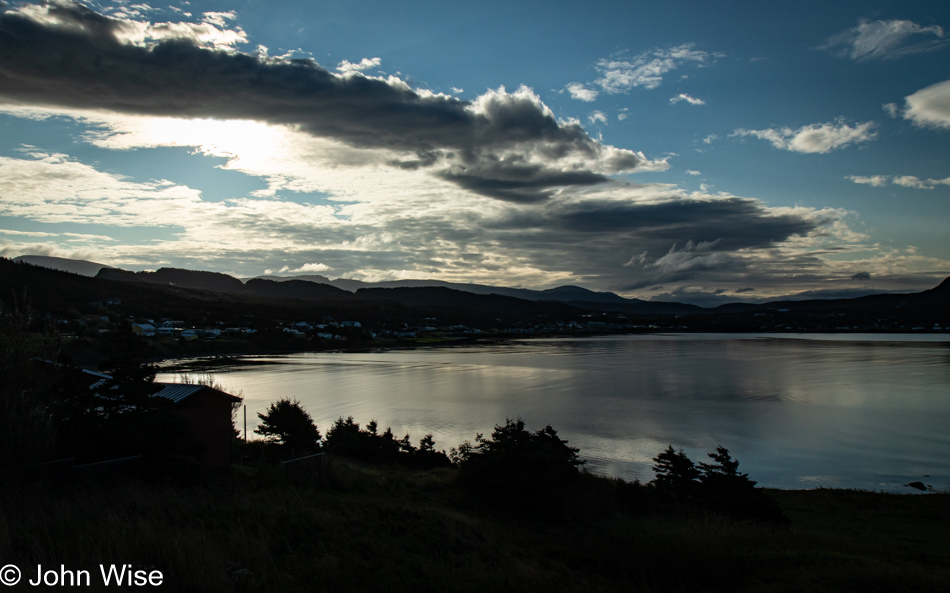
In years past, when we began to understand the calculus of time and budget against the constraints of lifespans, health, and curiosity, it was a conundrum to me that we are not awake at an earlier age to understand the value of what is obtained when experiencing the novelty found in new places, foods, conversations, ideas, and the struggle to learn how to be open to such things. Instead, we trade delight and a greater potential for happiness for consumer certainties that are supposed to deliver the ecstasy of existence, but that’s a marketing lie intended to mold impressionable people into obedient consumers requiring therapy, alcohol, pharmaceuticals, and illicit drugs so they can mask the ill effects of a life that seems to be failing to bring joy. Please believe me; I’m well aware of my pollyanna-esque and overly idealistic viewpoint that everything is healed and made better by falling into new experiences. We also require a fair amount of education to decipher the world we are out discovering, and simple survival isn’t always an easy way forward, but the majority of North Americans I encounter have skewed, broken, and downright deranged views about where happiness can be found. And while one size does not fit all, there are universal truths, such as the fact that humans must look out and forward, that we must feed our senses with new information, and that most of us are easily delighted when seeing rainbows, leaping dolphins, wagging dog tails, and the smiles of babies, so, while we may not be adept at appreciating the face of big nature, I believe that’s because we are not familiar enough with such pleasantries.

This is not a television episode, nor is it a TikTok clip; it’s not a sporting event or a job promotion. It is simply the sea reflecting the sky bordered by mountains, cliffsides, grasses, bushes, and two pairs of eyes admiring the idyllic beauty of a Newfoundland landscape that is absolutely new to the senses of the people owning those eyeballs. Should you be foolish enough to read this stuff, you must sometimes ask if any of this is what’s flowing through my head at these precise moments. The answer would be a combination of yes and no because much of this is written after our visit, and some of the thoughts arise from my observations about why we were alone out here and why, at home, I seemingly never find people to eavesdrop on who are extolling the magnitude of experiences found in places of great solitude.
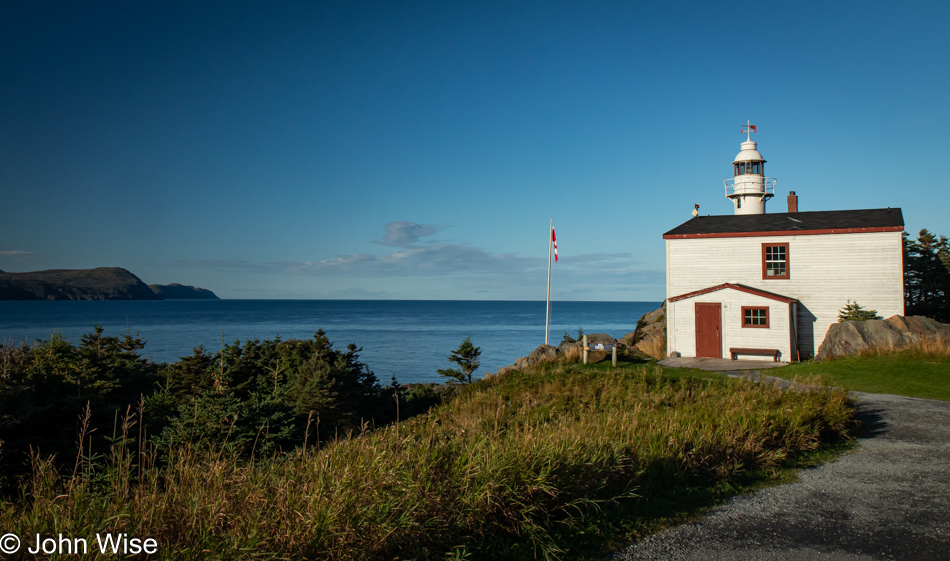
Then, there’s the contradiction of my words compared to what we enjoy while often being the only visitors to a destination. I say through one side of my mouth that others should be out here sharing the experience, then we run into another couple who were out here before our arrival only to have us intruding on their solitude and me feeling as though they were somehow going to spoil our visit. So, what do you want John? Total isolation or a vibrant bunch of fellow travelers? And what if they end up being tourists? These are the conundrums facing places like Venice, Italy; Santorini, Greece; or Barcelona, Spain, that have become victims of their success in attracting visitors, and if over-tourism were to occur out here on the Great Northern Peninsula of Newfoundland, my experience would surely suffer. All the same, I still believe I’d enjoy having others to compare notes with who also share this profound love Caroline and I have for places of stunning beauty. [We did end up chatting with the other couple for a while, something that would happen over and over on this trip: good conversations with friendly strangers, whether people working the shops and hotels or fellow travelers. – Caroline]

After writing the last few paragraphs, I’ve been struggling and considered eliminating them more than once to allow a more poetic jaunt in penning the words that might relate some of the awe-inspiring and stark beauty playing a central role in this landscape. This, though, is my public journal, where I have near-total control over the conversation I’m having with myself. I say near-total as my wife (editor) has worked hard to help me avoid the embarrassment of veering into being a total noodge stuck in the depths of crankiness that would overwhelm the better parts of the dialog I present here.

Today’s survey of this remote peninsula will not include L’Anse aux Meadows National Historic Site further north. During our travel planning, the idea of dedicating a day of driving over 300 miles (482km) to the UNESCO World Heritage Site, a day to wander the grounds, and a day of returning to where the drive would have begun seemed excessive to visit an archeological recreation of what might have been there about 1,000 years ago. Now, after seeing this landscape, I’d like to look out over the area where the Labrador Sea meets the Atlantic Ocean to consider what Leif Erikson and his explorers might have been seeing and encountering nearly 500 years before Christopher Columbus landed in the Americas. When the Vikings came here, Indigenous inhabitants known as the Beothuk people already lived on the island, but they didn’t survive later European encounters. The last Beothuk people died in 1829. While Flowers Cove is only 75 miles (120km) from the site, the timing cannot work today as we are already pressing into the late day with this change of plans. We’ve not been in Newfoundland 24 hours yet, and we already have two places on the map drawing us back for a return visit, Gros Morne and L’Anse aux Meadows.

All travels are a bridge to somewhere, and if a tiny morsel of phone connectivity allows for internet searches, you can rest assured that Caroline will be on the hunt for important stuff, such as our next stop.

In a peculiarly named tiny coastal town called Cow Head, with a population of only about 500 people, Caroline found the only yarn shop on the Great Northern Peninsula; it is called Skivvers Fibre Studio, and they were open. Before even looking at a single skein of yarn, Jessica, the young lady operating the shop on this day, offered to show us around with our first stop at a pan of recently harvested Japanese indigo leaves grown by the owner, Veronica Bavis. Walking into the shop’s dye lab, we passed a couple of looms and at least one spinning wheel, and we were both surprised at the level of sophistication and capabilities working here at such a remote outpost and in such a tiny space. As the conversation moved through the various fiber arts, the quest for local yarns was voiced, and we were shown the very limited quantities. Three handspun hand-dyed skeins were on hand, and we chose the yarn dyed with logwood and cochineal and a skein of a natural color blended with odds and ends from needle-felting roving spun into it. They were spun with Newfoundland heritage wool. The black skein of uncertain origin was left on the shelf.
But there was more: we don’t visit faraway yarn stores without me grabbing at least one skein of sock yarn, and today was no different. I opted for a black walnut bark hand-dyed 75% Superwash Merino wool with a 25% nylon blend (that last part is for durability, and trust me, you need that nylon). Caroline also picked yarn for a pair of socks for herself, dyed with cochineal and various flowers. Finally, a group called Fleece Artist from Halifax, Nova Scotia, created a series of yarns with colorways based on the hues and tones found in some of the most famous Canadian national parks. This skein is for Claudia over in Germany, inspired by the colors found in the Gros Morne National Park we’ve been driving through this morning.

Having spent a considerable amount of time at Skivvers, only halfway to Flowers Cove, we had to press the gas pedal and stop dillydallying. An hour later, we were at Hawke’s Bay with another hour to go before reaching our destination if we could resist stopping for more photos.

That intention didn’t last long when we stopped for this shot only 20 miles further north. We were looking up the road from near Barr’d Harbour.

Another forty miles, and if for no other reason than its name, we had to stop to memorialize Deadmans Cove. The vantage point is failing us as it’s not adequately showing the glacially shaved rocks just offshore that are mostly a uniform height and were the real draw that had me pulling over. When considering the effects of the last ice age, it’s dumbfounding to think that there were between 1.2 and 1.9 miles (2 – 3km) of glacial ice covering these lands, and to this day, the northern side of the island is still experiencing a post-glacial rebound where the land is rising. I don’t know how others’ imaginations work, but the idea that I could be standing in front of a wall of ice between 6,300 and 10,000 feet (2,000 and 3,000 meters) directly in front of me, stretching high into the sky, baffles my senses to their core.

Another mile and Bear Cover near Salmon Rock was making such a perfect reflection of the dramatic shift in the sky that an extra minute added to the drive wouldn’t matter. Plus, we were now only three miles away from the thrombolites.

This is and isn’t a thrombolite; more importantly, it is not a stromatolite. This lichen has taken up a position on a thrombolite, but this doesn’t offer any clue about the size and shape of these extraordinary 450- to 470-million-year-old fossils. For age comparison, dinosaurs existed between 66 million and 245 million years ago.

Cyanobacteria formed both thrombolites and stromatolites; the difference lies in how they fossilized. The thrombolites found here at Flowers Cove formed by a fossilization process where the structures in the cyanobacteria clumped together due to irregular periods of calcification. The Greek word thrombos means “clot.” On the other hand, stromatolites fossilize in a layered manner, also known as lamination, and show a clear, repetitive growth pattern. When these fossils were alive hundreds of millions of years ago, they were environmental engineers producing oxygen, sequestering carbon dioxide, and creating habitats for other early life. In effect, they helped pave the way for making the planet habitable for the explosion of life about to leave the oceans, coinciding with the emergence of the earliest land-based plant life.

Caroline stands in for the banana to show the comparative size of these fossils. If you look to the left, you’ll see a boulder sitting atop the fossils; it’s a glacial erratic, which, in case you don’t know, is a rock that a retreating glacier has transported here. If you think you are seeing another glacial erratic further to the left, that was a spinning-top mushroom-shaped thrombolite that appears to have broken off its foundation.

Caroline and I each went our own ways to examine the details of the fossil field, looking for angles that somehow spoke to us. It’s not easy to take in and decipher the magnitude of what role these thrombolites played in changing earth’s chemistry so we’d one day be able to stand at the seashore atop these ancient reminders of what were once lifeforms and contemplate our place in the long tree of life.

Being here at low tide was opportune as it allowed us to investigate many more thrombolites that would at other times be surrounded by seawater, but even with the low water levels, getting to the other side south of where we were would have either required a boat, or a walk around deeper water to which our limited time was saying no. Even with a slightly shorter drive south (we were staying in Deer Lake about 35 miles northeast of where we began this morning), we still had close to 200 miles ahead of us before checking into our hotel. By the time we had snapped more photos than we could ever share, we’d spent a solid hour among the ancients and could have easily used a second hour.

I joked with Caroline that I was going to turn left as I’d decided at the last minute that we would have to visit L’Anse aux Meadows and that I didn’t care if we had to drive back in the dark, in the rain, risking hitting a moose or caribou, we needed to commit to driving that extra hour to take a peek, but I was joking, and she wasn’t falling for me trying to bait her. Instead, we are near Plum Point, admiring the dwarf trees after stopping for gas and soft serve.

This is the River of Ponds. Somehow, there’s a lot to unpack with that name that I can’t really understand even as I write this, but there’s something there. It’s funny how particular words or a sequence of words resonate differently with different people. Who hasn’t fixated on a word for a time because it strikes their ear in a peculiar way, staying with them for hours or even days and becoming an earworm? When Caroline and I were early in our relationship, there was something about my enunciation of the word “difficult” that struck her ear, having her share with me how much she enjoyed how it sounded. For a moment, the sequence “River of Ponds” says something to me, inexplicable in its construct but intriguing with what it paints in my hearing and thought.

Still on the same bridge over the River of Ponds, where you can see a pond in the background, while behind it, well out view, is the River of Ponds Lake that’s about 9 miles long fed by a series of other ponds all nestled in the forest like a series of Matryoshka dolls, except they’re made of water and each successive pond is not always smaller or larger than the next. Maybe my analogy was a bit of a leap, but if you consider the forest the container of variable-sized bodies of water, you might catch a glimpse of what I’m inferring.

For the most part, we were driving straight through on our way south. This was in Parson’s Pond, about 10 miles north of Cow Head, looking north.
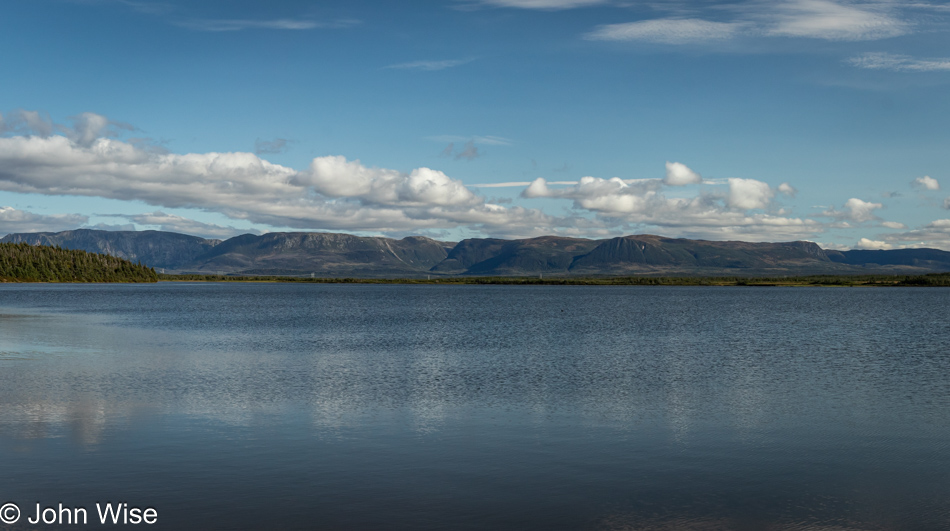
We were pulling over again only half a mile further, this time in front of Moulting Pond, on the southern end of Parson’s Pond. Maybe I should point out that the body of water seen in the photo above this one is not a bay affected by the changing tides of the Gulf of St. Lawrence but the town’s namesake, Parson’s Pond, probably the largest pond I’ve ever seen, and we could only see a tiny fraction of it. Then, consider that this pond right here, of which you cannot see all, is possibly 1/20th in size compared to its giant neighbor.

While you can’t see it from here, nor could we, I thought I’d use this view that looks far into the distance to add a note about the future. Earlier in the post, I mentioned that we already have two reasons for returning to Newfoundland. Well, here’s a third. In the far north, east of the Viking site of L’Anse aux Meadows, lies Quirpon Island, with a lighthouse and the former lightkeeper’s home that now acts as an inn for a small handful of visitors. To get to the 1.5 by 3.4 mile (5.5 km by 2.5 km) tiny island, one of the three staff members picks up visitors in a Zodiac for transport to the island and a beautiful 3.4 mile (5.5km) hike after you land that brings you to the lighthouse. Meals are included, and while a bit pricey at $850 for two nights, it is high on the list of places to return to, and reason #3.

What do we sacrifice when knowing that we can’t have it all? Nothing, because even when finding the tiniest experiential morsel, we’ve already had it all. We must relish those things we have acquired from these ephemeral realms, knowing that impressions are all we are allowed to carry with us and that there is no possibility of pulling the magnitude of everything into our being. There will always be things undone, people unknown, conversations lost, and opportunities just outside of our grasp. We can focus on what is denied us, or we can find enchantment in the breadth of what has been won, achieved, and shared, as well as the potential of this new information to inform a better tomorrow.

Here we are back in the Gros Morne National Park, and Caroline is recognizing that we have made such great time returning to where our day began that we might, after all, have the opportunity to collect an experience from the park that was at the top of the list of activities originally planned for today.

We arrived at the Tablelands trailhead at 6:30 for a hike that must be compressed into something significantly shorter than our typical indulgent hiking times if we were going to cover the 2.5 miles (4km) easy walk to the end of the trail and return to the car before dark. With no time to waste, we got moving, not sprinting, but not dawdling either. This is where the second unfamiliar word in today’s blog post title comes in: we are hiking on ophiolite.

Ophiolite is part of the earth’s mantle and can also be found on the ocean floor; neither place is easy to explore. Through uplift and the plate tectonics that move continents, this corner of Newfoundland features a large area of this rare bit of earth. The soils made from the various minerals that constitute ophiolite are poor in nutrients and high in toxic metals, so for plant life to take hold is a struggle, which is why much of this area at Tablelands is barren. Had we arrived an hour before, my photos would have offered better examples of the orange and rust hues of the iron-heavy mantle. Reading about how this part of earth became exposed from the depths of our planet, I learned that it was the closing of a long-gone ocean, the Iapetus Ocean, to be specific, after the super-continent Rodinia was breaking up into Gondwana, followed by Pangaea which leads us to our current landmass configuration. The closing of Iapetus that produced the Tablelands was also responsible for forming the Appalachian Mountain range.

Reason #4 inspiring a return visit to Newfoundland: an hour at the Tablelands will never suffice. Plus, I forgot to lick a rock to learn what ophiolite tastes like. By the way, it is no coincidence that today’s shirt is ophiolite-colored; everything is going according to plan, my plans within plans. I wonder if I lick the ophiolite, will I be able to transform into a Third Stage Guild Navigator?

What a modern-day yellow brick road looks like to me. Do you wonder what we found at the end of the boardwalk? We found a waterfall, but sadly, it was not the Water of Life; ask me how I know. My apologies if these references to the 1984 version of Frank Herbert’s Dune made by David Lynch have failed to resonate with you. They entertain Caroline and me, and that’s all that matters.

In the fading light of the day, but not so little that I couldn’t capture one decent photo of this slipper-wearing caribou, we have now seen a real caribou in the wild for the first time in our lives.

We weren’t finished wresting more from a day that kept giving. We continued until we reached the end of the road found in Trout River and exhausted all of the possibilities of adding more to more.

This was the end of the road, but not the end of the adventure. After our race to the seashore to gather the last moments of light from the distant sun and now hungry, I asked Caroline to check the door of the Seaside Restaurant right next to the beach we were standing on while I fetched the car. We were certain it was already closed, but to our surprise, they were open and willing to feed us. From there, a cascade of wonder unfolded.
We craved something fresh to whet our appetites, which arrived in the form of a salad, a little reluctantly as we always enjoy splitting steamed mussels, but this would be our introduction to partridgeberries we’d fall in love with. They are similar to lingonberries; maybe they are the same thing, but these were bona fide Newfoundland partridgeberries and a flavor we hadn’t anticipated enjoying out here. While we were waiting for the main course, Caroline visited a nearby sales rack on one side of the dining area to peruse the wares, where she found a bottle of bakeapple sauce and a small jar of partridgeberry spread. The bakeapples (strange name) are very similar to cloudberries found in Scandinavia. [I have read a few times now that the name derives from the French “baie qu’appelle?” or “What’s this berry called?” I would also like to add once more that I couldn’t believe that we ran into so many friendly people today, from the couple at the lighthouse in the morning, Jessica at the yarn store, locals near the Tableland trail who alerted us to the possibility that we might see a caribou, to our lovely hosts at the Seaside Restaurants. – Caroline]
Dinner, too, veered into the exotic, as who can say they’ve enjoyed a meal of cod tongues? We can, but to be clear, the name of this dish is a bit deceptive because a cod tongue is a piece of meat harvested from near the gill that is kind of a cross between fish and scallops. They are not tongues, as cod do not have such things. Desert was a shared slice of partridgeberry pie and the delight that arrived with a perfect day that, for 14 solid hours, delivered everything required to create non-stop astonishment. Yeah, that was our day.